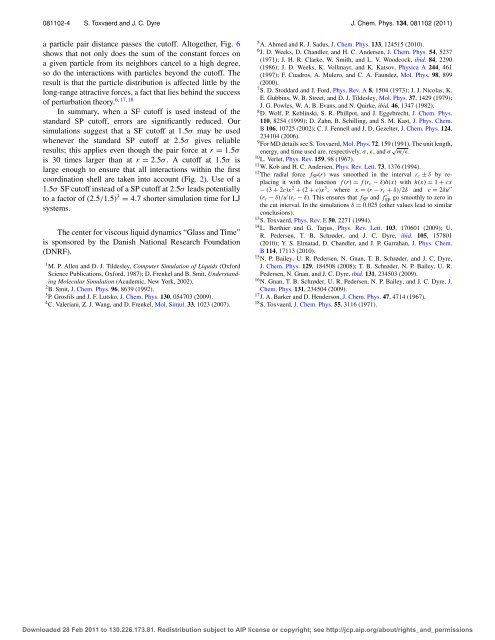Communication: Shifted forces in molecular dynamics - dirac
Communication: Shifted forces in molecular dynamics - dirac
Communication: Shifted forces in molecular dynamics - dirac
You also want an ePaper? Increase the reach of your titles
YUMPU automatically turns print PDFs into web optimized ePapers that Google loves.
081102-4 S. Toxvaerd and J. C. Dyre J. Chem. Phys. 134, 081102 (2011)<br />
a particle pair distance passes the cutoff. Altogether, Fig. 6<br />
shows that not only does the sum of the constant <strong>forces</strong> on<br />
a given particle from its neighbors cancel to a high degree,<br />
so do the <strong>in</strong>teractions with particles beyond the cutoff. The<br />
result is that the particle distribution is affected little by the<br />
long-range attractive <strong>forces</strong>, a fact that lies beh<strong>in</strong>d the success<br />
6, 17, 18<br />
of perturbation theory.<br />
In summary, when a SF cutoff is used <strong>in</strong>stead of the<br />
standard SP cutoff, errors are significantly reduced. Our<br />
simulations suggest that a SF cutoff at 1.5σ maybeused<br />
whenever the standard SP cutoff at 2.5σ gives reliable<br />
results; this applies even though the pair force at r = 1.5σ<br />
is 30 times larger than at r = 2.5σ . A cutoff at 1.5σ is<br />
large enough to ensure that all <strong>in</strong>teractions with<strong>in</strong> the first<br />
coord<strong>in</strong>ation shell are taken <strong>in</strong>to account (Fig. 2). Use of a<br />
1.5σ SF cutoff <strong>in</strong>stead of a SP cutoff at 2.5σ leads potentially<br />
to a factor of (2.5/1.5) 3 = 4.7 shorter simulation time for LJ<br />
systems.<br />
The center for viscous liquid <strong>dynamics</strong> “Glass and Time”<br />
is sponsored by the Danish National Research Foundation<br />
(DNRF).<br />
1 M. P. Allen and D. J. Tildesley, Computer Simulation of Liquids (Oxford<br />
Science Publications, Oxford, 1987); D. Frenkel and B. Smit, Understand<strong>in</strong>g<br />
Molecular Simulation (Academic, New York, 2002).<br />
2 B. Smit, J. Chem. Phys. 96, 8639 (1992).<br />
3 P. Grosfils and J. F. Lutsko, J. Chem. Phys. 130, 054703 (2009).<br />
4 C. Valeriani, Z. J. Wang, and D. Frenkel, Mol. Simul. 33, 1023 (2007).<br />
5 A. Ahmed and R. J. Sadus, J. Chem. Phys. 133, 124515 (2010).<br />
6 J. D. Weeks, D. Chandler, and H. C. Andersen, J. Chem. Phys. 54, 5237<br />
(1971); J. H. R. Clarke, W. Smith, and L. V. Woodcock, ibid. 84, 2290<br />
(1986); J. D. Weeks, K. Vollmayr, and K. Katsov, Physica A 244, 461<br />
(1997); F. Cuadros, A. Mulero, and C. A. Faundez, Mol. Phys. 98, 899<br />
(2000).<br />
7 S. D. Stoddard and J. Ford, Phys.Rev.A8, 1504 (1973); J. J. Nicolas, K.<br />
E. Gubb<strong>in</strong>s, W. B. Street, and D. J. Tildesley, Mol. Phys. 37, 1429 (1979);<br />
J. G. Powles, W. A. B. Evans, and N. Quirke, ibid. 46, 1347 (1982).<br />
8 D. Wolf, P. Kebl<strong>in</strong>ski, S. R. Phillpot, and J. Eggebrecht, J. Chem. Phys.<br />
110, 8254 (1999); D. Zahn, B. Schill<strong>in</strong>g, and S. M. Kast, J. Phys. Chem.<br />
B 106, 10725 (2002); C. J. Fennell and J. D. Gezelter, J. Chem. Phys. 124,<br />
234104 (2006).<br />
9 For MD details see S. Toxvaerd, Mol. Phys. 72, 159 (1991). The unit length,<br />
energy, and time used are, respectively, σ , ɛ, andσ √ m/ɛ.<br />
10 L. Verlet, Phys. Rev. 159, 98 (1967).<br />
11 W. Kob and H. C. Andersen, Phys. Rev. Lett. 73, 1376 (1994).<br />
12 The radial force f SP (r) was smoothed <strong>in</strong> the <strong>in</strong>terval r c ± δ by replac<strong>in</strong>g<br />
it with the function f (r) = f (r c − δ)h(x) with h(x) = 1 + cx<br />
− (3 + 2c)x 2 + (2 + c)x 3 , where x = (r − r c + δ)/2δ and c = 2δu ′′<br />
(r c − δ)/u ′ (r c − δ). This ensures that f SP and f SP ′ go smoothly to zero <strong>in</strong><br />
the cut <strong>in</strong>terval. In the simulations δ = 0.025 (other values lead to similar<br />
conclusions).<br />
13 S. Toxvaerd, Phys.Rev.E50, 2271 (1994).<br />
14 L. Berthier and G. Tarjus, Phys. Rev. Lett. 103, 170601 (2009); U.<br />
R. Pedersen, T. B. Schrøder, and J. C. Dyre, ibid. 105, 157801<br />
(2010); Y. S. Elmatad, D. Chandler, and J. P. Garrahan, J. Phys. Chem.<br />
B 114, 17113 (2010).<br />
15 N. P. Bailey, U. R. Pedersen, N. Gnan, T. B. Schrøder, and J. C. Dyre,<br />
J. Chem. Phys. 129, 184508 (2008); T. B. Schrøder, N. P. Bailey, U. R.<br />
Pedersen, N. Gnan, and J. C. Dyre, ibid. 131, 234503 (2009).<br />
16 N. Gnan, T. B. Schrøder, U. R. Pedersen, N. P. Bailey, and J. C. Dyre, J.<br />
Chem. Phys. 131, 234504 (2009).<br />
17 J. A. Barker and D. Henderson, J. Chem. Phys. 47, 4714 (1967).<br />
18 S. Toxvaerd, J. Chem. Phys. 55, 3116 (1971).<br />
Downloaded 28 Feb 2011 to 130.226.173.81. Redistribution subject to AIP license or copyright; see http://jcp.aip.org/about/rights_and_permissions

















